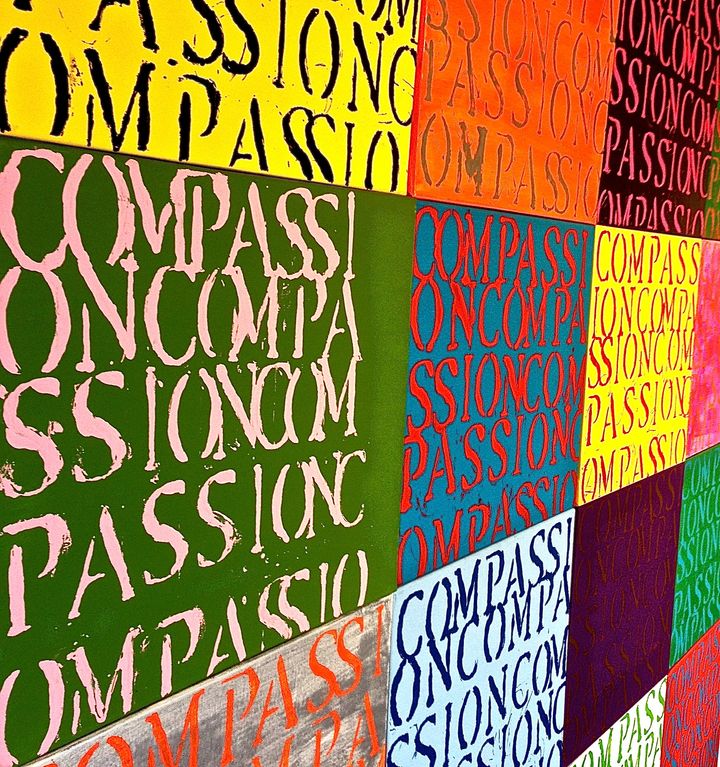
34 COMPASSION Paintings By John Schlimm
No matter who you are or where you are, you can be a compassion activist. You have the power to transform both your community and the world into better places—more loving and kinder places for all.
The tools you need to be a compassion activist are literally at your fingertips:
1. Use your talents to help others.
From the moment you were born, special talents specific to only you were sewn into your DNA. They are there, inside you, waiting to be discovered and put to good use—as a means for affecting compassion in your community and the world.
Ask yourself: “What talents do I have? How can I put them to use to help others?”
As far back as middle school, teachers told me I was a good writer. They helped me to cultivate that talent. Today, I’m able to use my books, essays, speeches, and social media posts to encourage people to live better, healthier, and more inspired lives.
My plant-based cookbooks—The Tipsy Vegan, Grilling Vegan Style, The Cheesy Vegan, and The Ultimate Beer Lover’s Happy Hour—have given me the opportunity to shine a tasty and fun spotlight on mealtime while also raising awareness about animals in factory farms and rescue shelters.
I used my first young adult book, Stand Up!, to highlight 75 of the world’s most dynamic young activists who embody compassion at its very best. The goal: To show readers the good work that is possible at any age.
And my memoir, Five Years in Heaven—about my life-changing friendship with an elderly nun, artist, and a compassion activist in her own right named Sister Augustine—has motivated readers across the country, and as far away as Korea and China, to tailor its universal lessons and solutions to their own lives. These include the mother of a drug addict who has drawn comfort from the advice I was given by Sister Augustine throughout the book; a grandma who has used the book to cope with the tragic cancer-death of her six-year-old grandson; a young man on the edge of despair who learned how to forgive and move forward after reading it; a teacher in Korea whose work has been enlightened by Sister Augustine’s powerful calm and humility; high school students who have emulated Sister’s art; and a quadriplegic, for whom Five Years in Heaven—read to him a chapter a night by his older brother—has helped him come to terms with his own mortality.
Your talents—as a baker, carpenter, manager, athlete, gardener, inventor, communicator, or whatever they may be—are the pebbles you can toss into the world to ignite ripples of compassion.
2. Use your hardships to help others.
We are all familiar with the adage, “To whom much is given, much is expected.”
However, I believe an even more powerful guiding principle is: From whom much is taken, much is also expected.
Let that sink in for a moment: From whom much is taken, much is also expected.
Each of our lives bears threads of sorrow, tragedy, and challenges. Deaths, illness, rejection, injury, abuse, despair. These hardships are inevitable ingredients that help forge who we are as individuals.
We can look at these experiences through the lens of a victim—with a woe is me attitude, and we can be left defeated. OR, we can embrace our sorrows, tragedies, and challenges as the humbling stepping-stones of a survivor. We can use them to make us stronger and more informed warriors for compassion.
Ask yourself: “What sorrows, tragedies, and challenges have I experienced? How can I put them to use to help others?”
Years of being bullied did not leave me recoiled in a corner somewhere. Those experiences super-charged the empathy and dedication I now have for helping victims of abuse—both people and animals—through such grassroots roles as board member at Citizens Against Physical, Sexual & Emotional Abuse, Inc. and as a volunteer at our local Humane Society shelter.
I’ve also channeled my experiences through books and essays like “Dare To Be Different,” “Battle Hymn of the Rejected,” and “My Spirit Animal is a Rescue Dog”; and in my university commencement address titled “The Road to YES is Paved with Many NOs” and the keynote I delivered on Capitol Hill titled “Embrace Compassion, Change the World.”
As an educator, I can sit with my students as they privately tell me about the depression, anxiety, and other issues they’re enduring, and I can respond from a place of personal reflection grounded upon my own battle scars. I’m able to reveal to them the greater potential of the journey they’re traversing: how their situation can be a new and impactful beginning for them, and not the hopeless quicksand they may think it is.
It is in these ways that we can each use our own journey through the darkest valleys to help others climb the daunting mountains rising before them.
3. Use your platform to help others.
Today more than ever, each one of us has a platform—a place from which we can spread compassion. No platform is too small or insignificant. What matters is that you use it!
For some of us, the nature of our careers—in my case as a teacher, writer, and artist—provides an organic forum for reaching out to others. But regardless of who you are or where you are, the most important tool you have as a compassion activist is your voice.
Through social media, you can share positive messages or information about your favorite charities and passion projects. My social media feeds are populated by selfies with the rescue dogs I walk, in the hope of helping them find their forever homes.
You can also plant seeds of compassion in the daily circles you inhabit—book clubs, church groups, your job, at the gym, a chance encounter with a stranger, a night out with friends, and so on.
Ask yourself: “What platforms do I have? How can I put them to use to help others?”
As an artist, my most recent works have been participatory pieces, such as THE SMILE THAT CHANGED THE WORLD (is yours) and Planting COMPASSION. Each of these works is a platform that allows me to engage with people, pulling them in as co-creators of the common good.
As compassion activists, we are all co-creators of the common good.
By using your platforms—big and small—you manifest the empowered message that the ability to transform both your community and the world into better places is always within reach.
